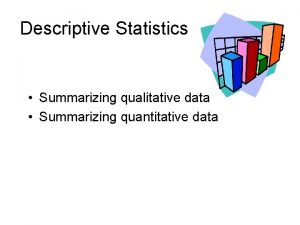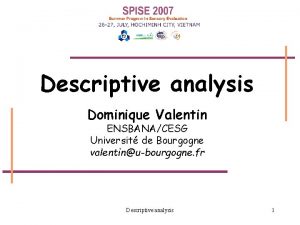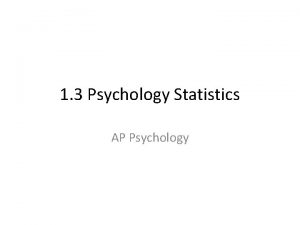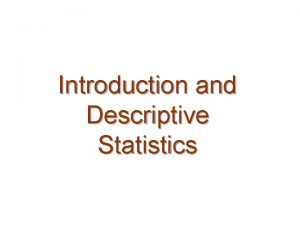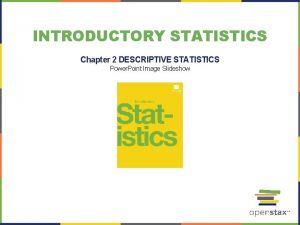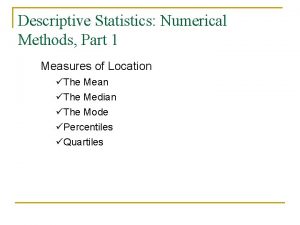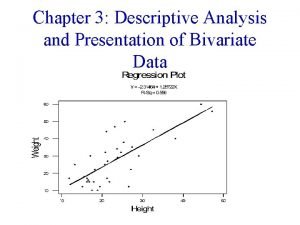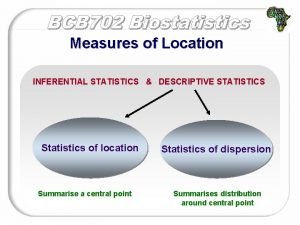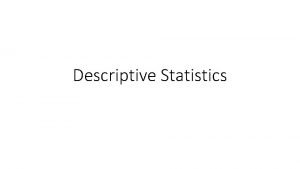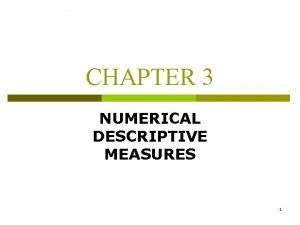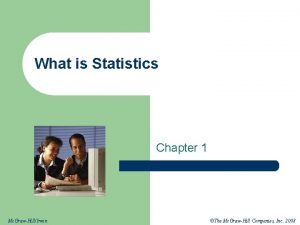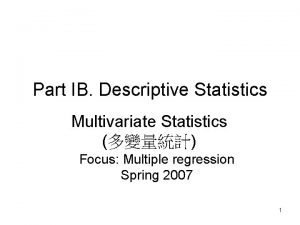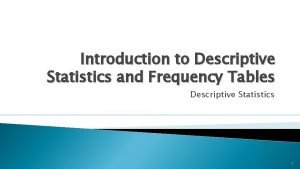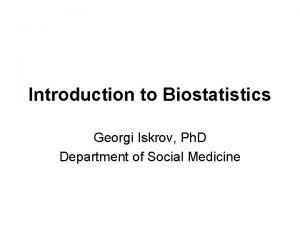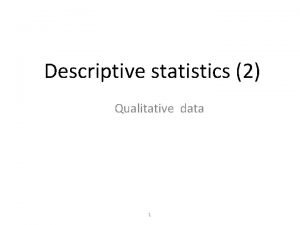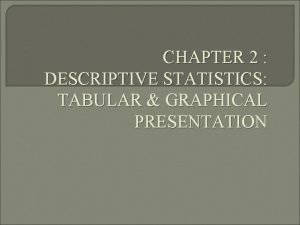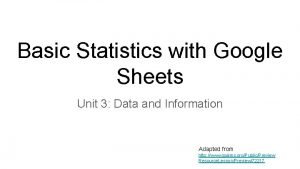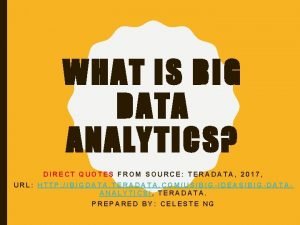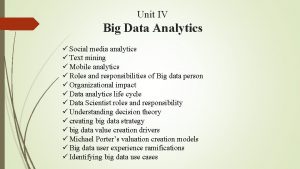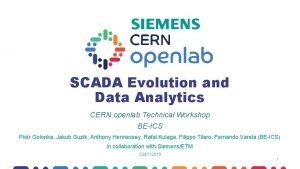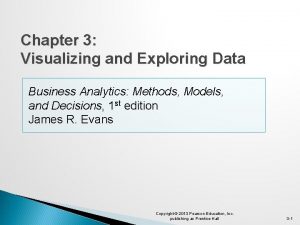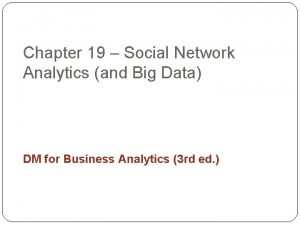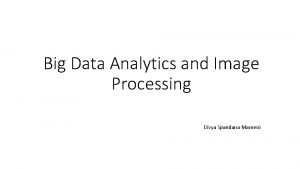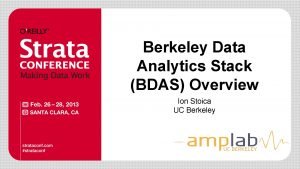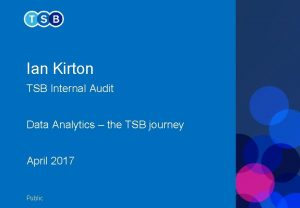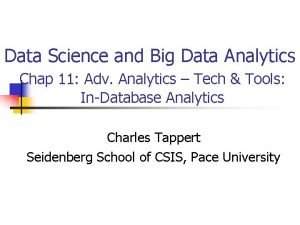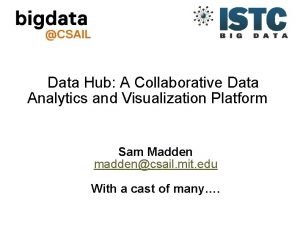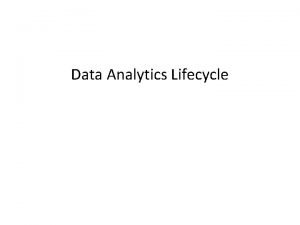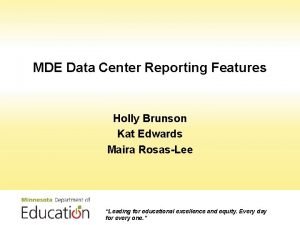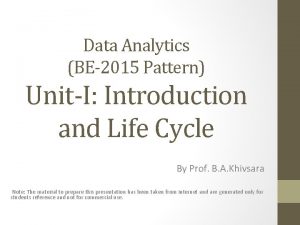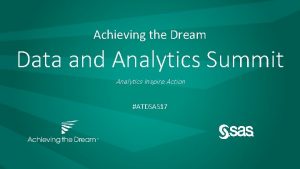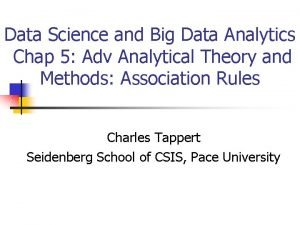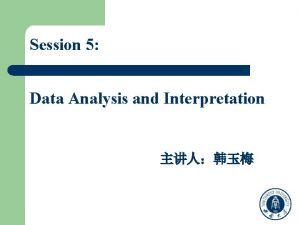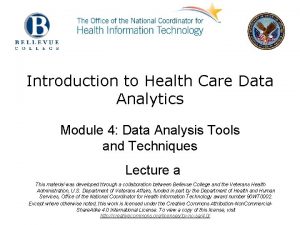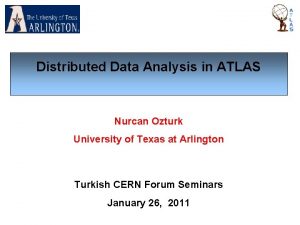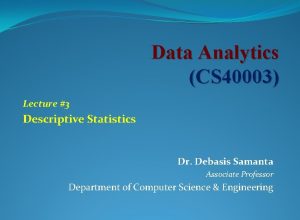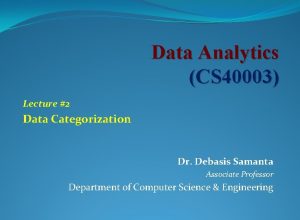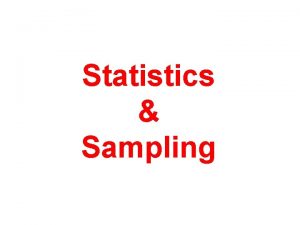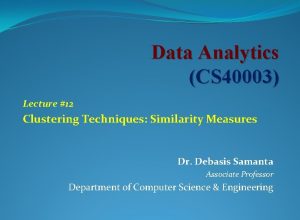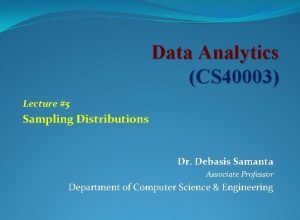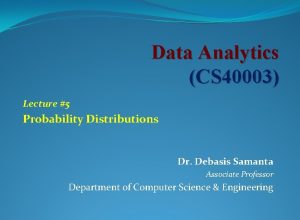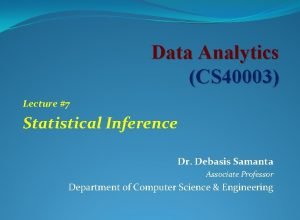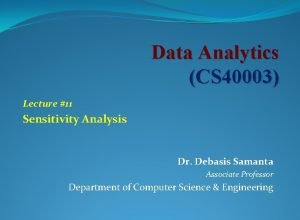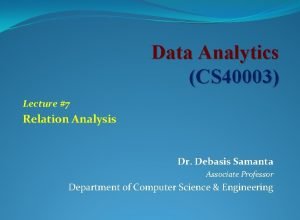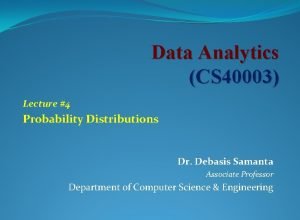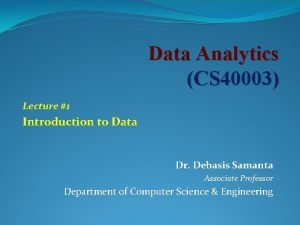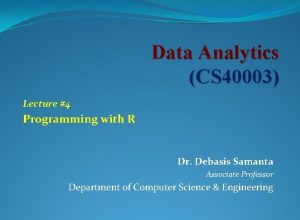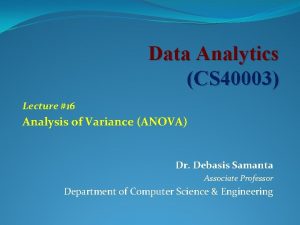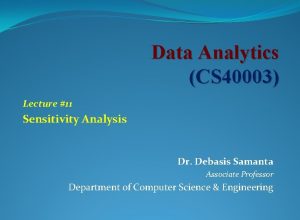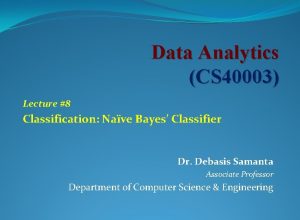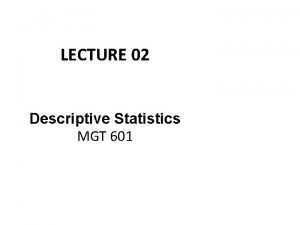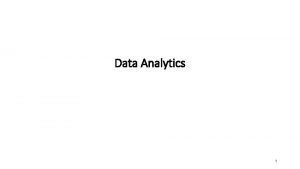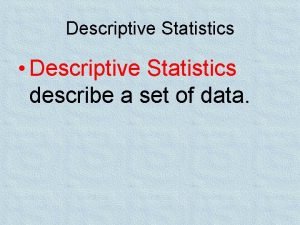Data Analytics CS 40003 Lecture 3 Descriptive Statistics













































































- Slides: 77

Data Analytics (CS 40003) Lecture #3 Descriptive Statistics Dr. Debasis Samanta Associate Professor Department of Computer Science & Engineering

Quote of the day. . �Change your thoughts and you change your world. � NORMAN VINCENT PEALE, American - Clergyman CS 40003: Data Analytics 2

Just a minute to mark your attendance CS 40003: Data Analytics 3

Today’s discussion… � Introduction � Data summarization � Measurement of location � Mean, median, mode, midrange, etc. � Measure of dispersion � Range, Variance, Standard Deviation, etc. � Other measures � MAD, AAD, Percentile, IQR, etc. • Graphical summarization • Box plot CS 40003: Data Analytics 4

TRP: An example � Television rating point (TRP) is a tool provided to judge which programs are viewed the most. � This gives us an index of the choice of the people and also the popularity of a particular channel. � For calculation purpose, a device is attached to the TV sets in few thousand viewers’ houses in different geographic and demographic sectors. � The device is called as People's Meter. It reads the time and the programme that a viewer watches on a particular day for a certain period. � An average is taken, for example, for a 30 -days period. � The above further can be augmented with a personal interview survey (PIS), which becomes the basis for many studies/decision making. � Essentially, we are to analyze data for TRP estimation. CS 40003: Data Analytics 5

Defining Data Definition 3. 1: Data A set of data is a collection of observed values representing one or more characteristics of some objects or units. Example: For TRP, data collection consist of the following attributes. � Age: A viewer’s age in years � Sex: A viewer’s gender coded 1 for male and 0 for female � Happy: A viewer’s general happiness � NH for not too happy � PH for pretty happy � VH for very happy � TVHours: The average number of hours a respondent watched TV during a day CS 40003: Data Analytics 6

Defining Data Viewer# … … 55 … Age … … 34 … Sex … … F … Happy … … VH … TVHours … … 5 … Note: � A data set is composed of information from a set of units. � Information from a unit is known as an observation. � An observation consists of one or more pieces of information about a unit; these are called variables. CS 40003: Data Analytics 7

Defining Population Definition 3. 2: Population A population is a data set representing the entire entities of interest. Example: All TV Viewers in the country/world. Note: 1. All people in the country/world is not a population. 2. For different survey, the population set may be completely different. 3. For statistical learning, it is important to define the population that we intend to study very carefully. CS 40003: Data Analytics 8

Defining Sample Definition 3. 3: Sample A sample is a data set consisting of a population. Example: All students studying in Class XII is a sample, whereas those students belong to a given school is population. Note: � Normally a sample is obtained in such a way as to be representative of the population. CS 40003: Data Analytics 9

Defining Statistics Definition 3. 4: Statistics A statistics is a quantity calculated from data that describes a particular characteristics of a sample. � CS 40003: Data Analytics 10

Defining Statistical Inference Definition 3. 5: Statistical inference is the process of using sample statistics to make decisions about population. Example: In the context of TRP � Overall frequency of the various levels of happiness. � Is there a relationship between the age of a viewers and his/her general happiness? � Is there a relationship between the age of the viewer and the number of TV hours watched? CS 40003: Data Analytics 11

Data Summarization � To identify the typical characteristics of data (i. e. , to have an overall picture). � To identify which data should be treated as noise or outliers. � The data summarization techniques can be classified into two broad categories: � Measures of location � Measures of dispersion CS 40003: Data Analytics 12

Measurement of location � It is also alternatively called as measuring the central tendency. � A function of the sample values that summarizes the location information into a single number is known as a measure of location. � The most popular measures of location are � � Mean Median Mode Midrange � These can be measured in three ways � Distributive measure � Algebraic measure � Holistic measure CS 40003: Data Analytics 13

Distributive measure � It is a measure (i. e. function) that can be computed for a given data set by partitioning the data into smaller subsets, computing the measure for each subset, and then merging the results in order to arrive at the measure’s value for the original (i. e. entire) data set. Example ü sum(), count() CS 40003: Data Analytics 14

Algebraic measure � CS 40003: Data Analytics 15

Holistic measure � It is a measure that must be computed on the entire data set as a whole. � Example Calculating median What about mode? CS 40003: Data Analytics 16

Mean of a sample � CS 40003: Data Analytics 17

Simple mean of a sample �Simple mean It is also called simply arithmetic mean or average and is abbreviated as (AM). Definition 3. 6: Simple mean CS 40003: Data Analytics 18

Weighted mean of a sample �Weighted mean It is also called weighted arithmetic mean or weighted average. Definition 3. 7: Weighted mean Note When all weights are equal, the weighted mean reduces to simple mean. CS 40003: Data Analytics 19

Trimmed mean of a sample �Trimmed Mean If there are extreme values (also called outlier) in a sample, then the mean is influenced greatly by those values. To offset the effect caused by those extreme values, we can use the concept of trimmed mean Definition 3. 8: Trimmed mean is defined as the mean obtained after chopping off values at the high and low extremes. CS 40003: Data Analytics 20

Properties of mean � CS 40003: Data Analytics 21

Properties of mean � CS 40003: Data Analytics 22

Properties of mean � CS 40003: Data Analytics 23

Mean with grouped data Sometimes data is given in the form of classes and frequency for each class. Class Frequency …. . There three methods to calculate the mean of such a grouped data. • Direct method • Assumed mean method • Step deviation method CS 40003: Data Analytics 24

Direct method � CS 40003: Data Analytics 25

Assumed mean method � CS 40003: Data Analytics 26

Step deviation method � CS 40003: Data Analytics 27

Mean for a group of data � 10 - 19 20 - 29 30 - 39 9. 5 – 19. 5 – 29. 5 – 39. 5 CS 40003: Data Analytics 28

Ogive: Graphical method to find mean � Ogive (pronounced as O-Jive) is a cumulative frequency polygon graph. � When cumulative frequencies are plotted against the upper (lower) class limit, the plot resembles one side of an Arabesque or ogival architecture, hence the name. � There are two types of Ogive plots � Less-than (upper class vs. cumulative frequency) � More than (lower class vs. cumulative frequency) Example: Suppose, there is a data relating the marks obtained by 200 students in an examination 444, 412, 478, 467, 432, 450, 410, 465, 435, 454, 479, ……. (Further, suppose it is observed that the minimum and maximum marks are 410, 479, respectively. ) CS 40003: Data Analytics 29

Ogive: Cumulative frequency table 444, 412, 478, 467, 432, 450, 410, 465, 435, 454, 479, ……. Step 1: Draw a cumulative frequency table Marks (x) 410 -419 420 -429 430 -439 440 -449 450 -459 460 -469 470 -479 CS 40003: Data Analytics Conversion into exclusive series 409. 5 -419. 5 -429. 5 -439. 5 -449. 5 -459. 5 -469. 5 -479. 5 No. of students Cumulative Frequency (f) 14 20 42 54 45 18 7 (C. M) 14 34 76 130 175 193 200 30

Ogive: Graphical method to find mean Marks (x) 410 -419 420 -429 430 -439 440 -449 450 -459 460 -469 470 -479 Conversion into exclusive series 409. 5 -419. 5 -429. 5 -439. 5 -449. 5 -459. 5 -469. 5 -479. 5 No. of students Cumulative Frequency (f) 14 20 42 54 45 18 7 (C. M) 14 34 76 130 175 193 200 Step 2: Less-than Ogive graph Upper class Less than 419. 5 Less than 429. 5 Less than 439. 5 Less than 449. 5 Less than 459. 5 Less than 469. 5 Less than 479. 5 CS 40003: Data Analytics Cumulative Frequency 14 34 76 130 175 193 200 31

Ogive: Graphical method to find mean Marks (x) 410 -419 420 -429 430 -439 440 -449 450 -459 460 -469 470 -479 Conversion into exclusive series 409. 5 -419. 5 -429. 5 -439. 5 -449. 5 -459. 5 -469. 5 -479. 5 No. of students Cumulative Frequency (f) 14 20 42 54 45 18 7 (C. M) 14 34 76 130 175 193 200 Step 3: More-than Ogive graph Upper class More than 409. 5 More than 419. 5 More than 429. 5 More than 439. 5 More than 449. 5 More than 459. 5 More than 469. 5 CS 40003: Data Analytics Cumulative Frequency 200 186 166 124 70 25 7 32

Information from Ogive � Mean from Less-than Ogive � Mean from More-than Ogive � A % C freq of. 65 for the third class 439. 5. . . 449. 5 means that 65% of all scores are found in this class or below. CS 40003: Data Analytics 33

Information from Ogive � Less-than and more-than Ogive approach A cross point of two Ogive plots gives the mean of the sample CS 40003: Data Analytics 34

Some other measures of mean �There are three mean measures of location: � Arithmetic Mean (AM) � Geometric mean (GM) � Harmonic mean (HM) CS 40003: Data Analytics 35

Some other measures of mean � CS 40003: Data Analytics 36

? ? ? � CS 40003: Data Analytics 37

Geometric mean Definition 3. 9: Geometric mean � CS 40003: Data Analytics 38

Harmonic mean Definition 3. 10: Harmonic mean CS 40003: Data Analytics 39

Significant of different mean calculations �There are two things involved when we consider a sample � Observation � Range Example: Rainfall data Rainfall (in mm) Days (in number) r 1 r 2 … rn d 1 d 2 … dn � Here, rainfall is the observation and day is the range for each element in the sample � Here, we are to measure the mean “rate of rainfall” as the measure of location CS 40003: Data Analytics 40

Significant of different mean calculations �Case 1: Range remains same for each observation Example: Having data about amount of rainfall per week, say. Rainfall (in mm) Days (in number) CS 40003: Data Analytics 35 18 … 22 7 7 … 7 41

Significant of different mean calculations �Case 2: Ranges are different, but observation remains same Example: Same amount of rainfall in different number of days, say. Rainfall (in mm) Days (in number) CS 40003: Data Analytics 50 50 … 50 1 2 … 7 42

Significant of different mean calculations �Case 3: Ranges are different, as well as the observations Example: Different amount of rainfall in different number of days, say. Rainfall (in mm) Days (in number) CS 40003: Data Analytics 21 34 … 18 5 3 … 7 43

Rule of thumbs for means � AM: When the range remains same for each observation Example: Case 1 Rainfall (in mm) Days (in number) 35 18 … 22 7 7 … 7 CS 40003: Data Analytics 44

Rule of thumbs for means � HM: When the range is different but each observation is same � Example: Case 2 Rainfall (in mm) Days (in number) 50 50 … 50 1 2 … 7 CS 40003: Data Analytics 45

Rule of thumbs for means � GM: When the ranges are different as well as the observations � Example: Case 3 Rainfall (in mm) Days (in number) 21 34 … 18 5 3 … 7 CS 40003: Data Analytics 46

Rule of thumbs for means � The important things to recognize is that all three means are simply the arithmetic means in disguise! � Each mean follows the “additive structure”. � Suppose, we are given some abstract quantities {x 1, x 2, …, xn} � Each of the three means can be obtained with the following steps 1. Transform each xi into some yi 2. Taking the arithmetic mean of all yi’s 3. Transforming back the to the original scale of measurement CS 40003: Data Analytics 47

Rule of thumbs for means � CS 40003: Data Analytics 48

Relationship among means � A simple inequality exists between the three means related summary measure as AM ≥ GM ≥ HM CS 40003: Data Analytics 49

Median of a sample Definition 3. 12: Median of a sample CS 40003: Data Analytics 50

Median of a sample Definition 3. 12: Median of a grouped data CS 40003: Data Analytics 51

Mode of a sample � Mode is defined as the observation which occurs most frequently. � For example, number of wickets obtained by bowler in 10 test matches are as follows. 1 2 0 3 2 4 1 1 2 2 � In other words, the above data can be represented as: # of matches 0 1 2 3 4 1 1 � Clearly, the mode here is “ 2”. CS 40003: Data Analytics 52

Mode of a grouped data Definition 3. 13: Mode of a grouped data CS 40003: Data Analytics 53

Relation between mean, median and mode � CS 40003: Data Analytics 54

Symmetric data � For symmetric data, all mean, median and mode lie at the same point CS 40003: Data Analytics 55

Positively skewed data � Here, mode occurs at a value smaller than the median CS 40003: Data Analytics 56

Negatively skewed data � Here, mode occurs at a value greater than the median CS 40003: Data Analytics 57

Empirical Relation! � There is an empirical relation, valid for moderately skewed data Mean – Mode = 3 * (Mean – Median) CS 40003: Data Analytics 58

Midrange � It is the average of the largest and smallest values in the set. Steps 1. A percentage ‘p’ between 0 and 100 is specified. 2. The top and bottom of (p/2)% of the data is thrown out 3. The mean is then calculated in the normal way � Thus, the median is trimmed mean with p = 100% while the traditional mean corresponds to p = 0% Note � Trimmed mean is a special case of Midrange CS 40003: Data Analytics 59

Measures of dispersion � Location measure are far too insufficient to understand data. � Another set of commonly used summary statistics for continuous data are those that measure the dispersion. � A dispersion measures the extent of spread of observations in a sample. � Some important measure of dispersion are: � Range � Variance and Standard Deviation � Mean Absolute Deviation (MAD) � Absolute Average Deviation (AAD) � Interquartile Range (IQR) CS 40003: Data Analytics 60

Measures of dispersion Example � Suppose, two samples of fruit juice bottles from two companies A and B. The unit in each bottle is measured in litre. Sample A 0. 97 1. 00 0. 94 1. 03 1. 06 Sample B 1. 06 1. 01 0. 88 0. 91 1. 14 � Both samples have same mean. However, the bottles from company A with more uniform content than company B. � We say that the dispersion (or variability) of the observation from the average is less for A than sample B. � The variability in a sample should display how the observation spread out from the average � In buying juice, customer should feel more confident to buy it from A than B CS 40003: Data Analytics 61

Range of a sample Definition 3. 14: Range of a sample � Range identifies the maximum spread, it can be misleading if most of the values are concentrated in a narrow band of values, but there also a relatively small number of more extreme values. � The variance is another measure of dispersion to deal with such a situation. CS 40003: Data Analytics 62

Variance and Standard Deviation Definition 3. 15: Variance and Standard Deviation CS 40003: Data Analytics 63

Coefficient variation �Basic properties � σ measures spread about mean and should be chosen only when the mean is chosen as the measure of central tendency � σ = 0 only when there is no spread, that is, when all observations have the same value, otherwise σ > 0 Definition 3. 16: Coefficient variation CS 40003: Data Analytics 64

Variance and Standard Deviation � CS 40003: Data Analytics 65

Mean Absolute Deviation (MAD) � CS 40003: Data Analytics 66

Interquartile Range � CS 40003: Data Analytics 67

Interquartile Range � CS 40003: Data Analytics 68

Application of IQR � CS 40003: Data Analytics 69

Application of IQR � CS 40003: Data Analytics 70

Box plot �Graphical view of Five number summary CS 40003: Data Analytics 71

Reference �The detail material related to this lecture can be found in Probability and Statistics for Enginneers and Scientists (8 th Ed. ) by Ronald E. Walpol, Sharon L. Myers, Keying Ye (Pearson), 2013 . CS 40003: Data Analytics 72

Any question? You may post your question(s) at the “Discussion Forum” maintained in the course Web page! CS 40003: Data Analytics 73

Questions of the day… 1. Which of the following central tendency measurements allows distributive, algebraic and holistic measure? mean • median • Mode Which measure may be faster than other? Why? • 2. Give three situations where AM, GM and HM are the right measure of central tendency? CS 40003: Data Analytics 74

Questions of the day… 3. Given a sample of data, how to decide whether it is a) Symmetric? b) Skew-symmetric (positive or negative)? c) Uniformly increasing (or decreasing)? d) In-variate? 4. How the box-plots will look for the following types of samples? a) Symmetric b) Positively skew-symmetric c) Negatively skew-symmetric d) in-variate CS 40003: Data Analytics 75

Questions of the day… � CS 40003: Data Analytics 76

Questions of the day… 5. What are the degree of freedoms in each of the following cases. a. b. c. A sample with a single data A sample with n data A sample of tabular data with n rows and m columns CS 40003: Data Analytics 77
 How to summarize qualitative data
How to summarize qualitative data Teramond
Teramond 01:640:244 lecture notes - lecture 15: plat, idah, farad
01:640:244 lecture notes - lecture 15: plat, idah, farad Ibm maximo scheduler demo
Ibm maximo scheduler demo Medical statistics lecture
Medical statistics lecture Descriptive statistics examples in business
Descriptive statistics examples in business Descriptive hypothesis
Descriptive hypothesis Example of descriptive statistics
Example of descriptive statistics Descriptive statistics ap psychology
Descriptive statistics ap psychology Introduction to descriptive statistics
Introduction to descriptive statistics Introductory statistics chapter 2 answers
Introductory statistics chapter 2 answers Numerical descriptive statistics
Numerical descriptive statistics Numerical methods of descriptive statistics
Numerical methods of descriptive statistics Bivariate descriptive statistics
Bivariate descriptive statistics Measures of location is a descriptive measure.
Measures of location is a descriptive measure. Kinds of descriptive statistics
Kinds of descriptive statistics Jack in box
Jack in box Variance standard deviation formula
Variance standard deviation formula Descriptive statistics definition
Descriptive statistics definition Data pensylvania1
Data pensylvania1 Definition of descriptive statistics
Definition of descriptive statistics Multivariate descriptive statistics
Multivariate descriptive statistics Categorical frequency distribution example
Categorical frequency distribution example Descriptive statistics
Descriptive statistics Descriptive statistics classification
Descriptive statistics classification Descriptive statistics tabular and graphical methods
Descriptive statistics tabular and graphical methods Descriptive statistics google sheets
Descriptive statistics google sheets Introduction to statistics what is statistics
Introduction to statistics what is statistics Quotes on data analytics
Quotes on data analytics Big data and social media analytics
Big data and social media analytics Temple data analytics challenge
Temple data analytics challenge Scada big data analytics
Scada big data analytics Data analytics lifecycle
Data analytics lifecycle Data analytics meaning
Data analytics meaning Visualizing and exploring data in business analytics
Visualizing and exploring data in business analytics Network analytics big data
Network analytics big data Scale up scale down
Scale up scale down What is the sequence of installations on rhipe
What is the sequence of installations on rhipe Big data analytics in image processing
Big data analytics in image processing Berkeley data analytics stack
Berkeley data analytics stack Internal audit data analytics maturity
Internal audit data analytics maturity Kpmg
Kpmg Siemens data analytics
Siemens data analytics Earth observing systems data analytics
Earth observing systems data analytics Audit data analytics
Audit data analytics Cis 545 big data analytics
Cis 545 big data analytics Data analytics association
Data analytics association Watson social media data analytics
Watson social media data analytics Tropim
Tropim Data analytics capability framework
Data analytics capability framework Temple data analytics challenge
Temple data analytics challenge Big data analytics is usually associated with
Big data analytics is usually associated with Deloitte analytics and information management
Deloitte analytics and information management Collaborative data analytics with datahub
Collaborative data analytics with datahub Discovery phase in data analytics
Discovery phase in data analytics Microservices data analytics
Microservices data analytics Big data analytics for national security
Big data analytics for national security Big data analytics by rajkamal
Big data analytics by rajkamal Big data rail
Big data rail Ait data analytics
Ait data analytics Mobile analytics big data
Mobile analytics big data What is high performance data analytics
What is high performance data analytics Mde data reports and analytics
Mde data reports and analytics High performance data analytics definition
High performance data analytics definition In data analytics lifecycle gina stands for
In data analytics lifecycle gina stands for Atd data and analytics summit
Atd data and analytics summit Yoav freund
Yoav freund Poultry data analytics
Poultry data analytics Graph analytics for big data
Graph analytics for big data Big data analytics life cycle
Big data analytics life cycle Semma
Semma Wake tech business analytics
Wake tech business analytics Data analysis definition
Data analysis definition Smu dsa
Smu dsa Earth observing systems data analytics
Earth observing systems data analytics Introduction to healthcare data analytics
Introduction to healthcare data analytics Predictive prescriptive analytics
Predictive prescriptive analytics Nurcan öztürk
Nurcan öztürk
